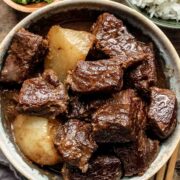Chinese Beef Stew
This Chinese braised beef stew with daikon recipe is a hearty dish that features tender chunks of beef and the savory flavors of the star anise braising liquid. With its roots in traditional Chinese cuisine, this stew is a comfort food classic that's perfect for a family dinner or a cozy night in.
Servings: 4
Calories: 495kcal
Ingredients
- 2 lbs beef chuck (1000g, aka. blade roast)
- 1 onion (approx. ½ cup)
- ½ bulb garlic (approx. 5 cloves, ¼ cup)
- 2 slices ginger
- 3 star anise
- 2 bay leaves
- 2 stalks green onion
- 1 small daikon radish (optional. approx. 1½ cups. Can sub for carrots.)
Braising Sauce
- 4 tablespoons hoisin sauce
- 1 cube red fermented bean curd (approx. 1 tablespoon)
- 2 tablespoons oyster sauce
- 2 tablespoons soy sauce
- 2 tablespoons Shaoxing wine
- 2½ cups water (or enough to just cover the beef. Can sub for no sodium beef broth)
- 1 teaspoon dark soy sauce (optional, for color)
Instructions
Preparation
- (Optional) If you're using tendon, it's essential to pressure cook it first for 40-45 minutes. This will guarantee that it becomes tender. After pressure cooking, trim off any excess fat.
- Slice 2 slices ginger and set it aside. Peel and slice 1 onion and set them aside for later.
- Peel ½ bulb garlic (approx. 5 cloves), then use the side of the knife to smash it. Keep whole (don't worry, they will melt into the sauce when we braise it).
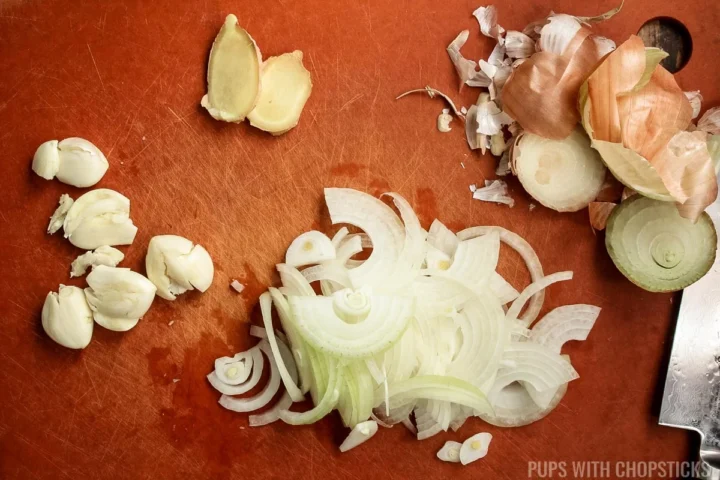
- Finely mince 2 stalks green onion and set them aside for the end.
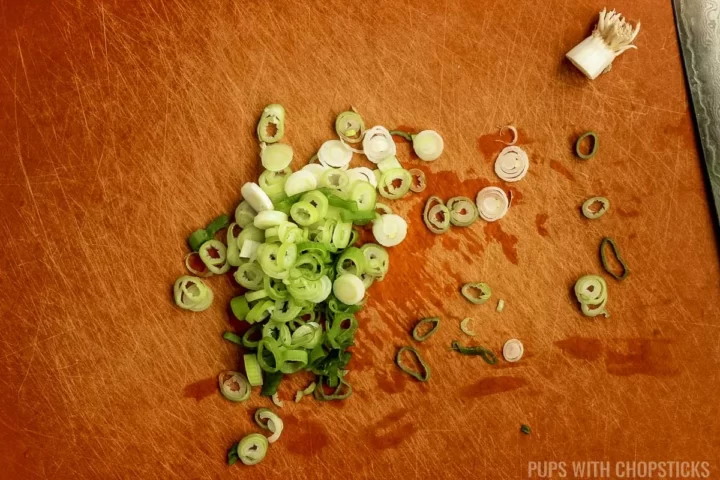
Prepare the Braising Sauce
- In a small bowl, mash 1 cube red fermented bean curd to break it up into small pieces. (sometimes they don't fully melt into the stew unless you break it up manually).
- Then mix in 4 tablespoons hoisin sauce, 2 tablespoons oyster sauce, 2 tablespoons soy sauce, 2 tablespoons Shaoxing wine, and 1 teaspoon dark soy sauce (or reg. soy sauce).
- Once the sauce is mixed, mix in 2½ cups water to it.
Prepare the Daikon Radish
- Peel 1 small daikon radish. To reduce the bitterness of daikon radishes, I peel them a few times until I reach the beige part. The outer layers of the daikon usually contain a more bitter flavor, so we don't want that to transfer to the stew.
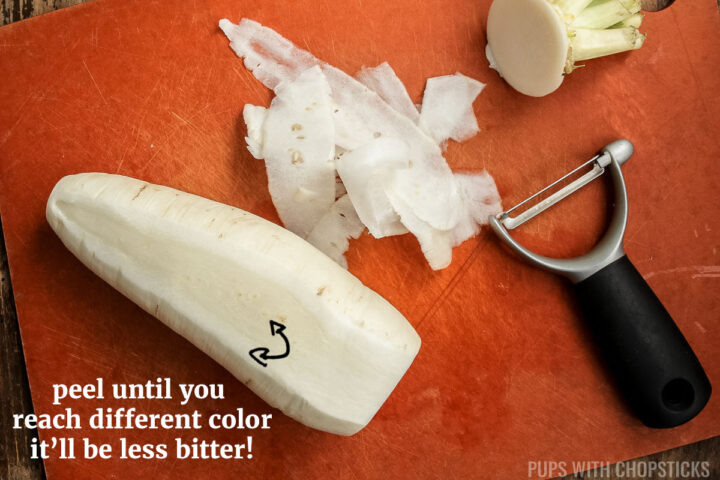
- Cut off the tip with the leaves, and discard it. Then cut the daikon into 1½ inch pieces.
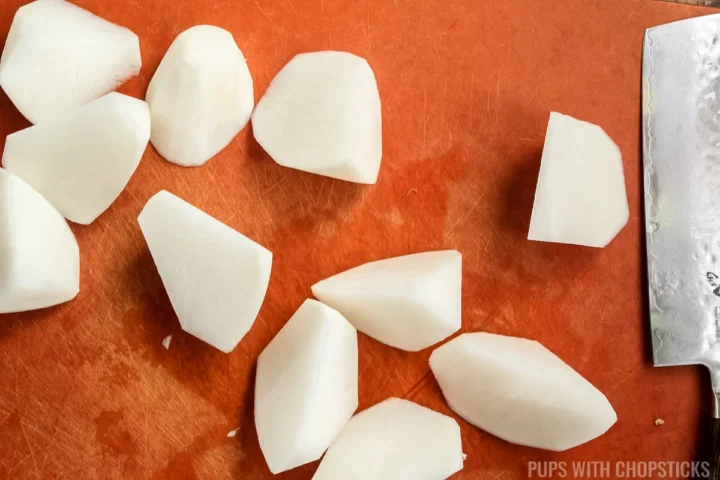
Prepare the Beef
- Cut 2 lbs beef chuck into 1 to 1½-inch cubes.
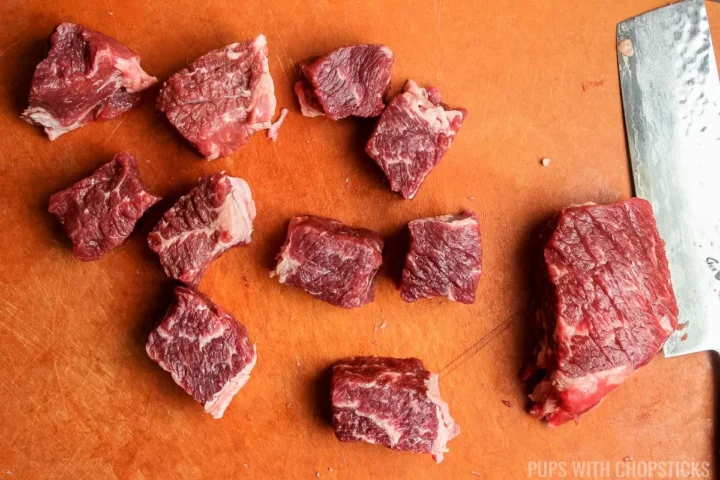
- To create a nice browning, pat the beef dry, and sprinkle a bit of salt on it. This will help with the Maillard reaction, which is the browning process, to give the beef stew more flavor.
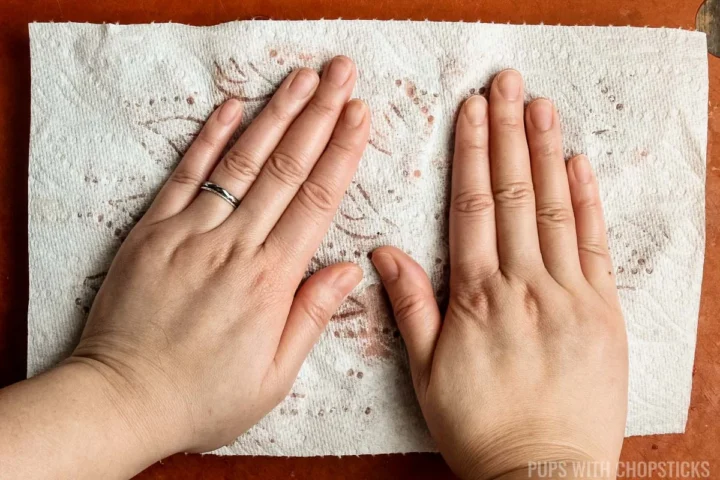
- Set the stove to Medium-High heat. Once the pan is hot, add oil to it (don't be shy with the oil, it will help with the browning and help the beef not stick to the pan). Add the beef in a single layer and brown for about 30 seconds per side. Don't flip it too soon, because it will rip the beef. You want a crust to form before you flip it. To remove it from the pan, I gently push the beef from the bottom of the pan to loosen it. You may need to do this in batches, if you're using a lot of beef.
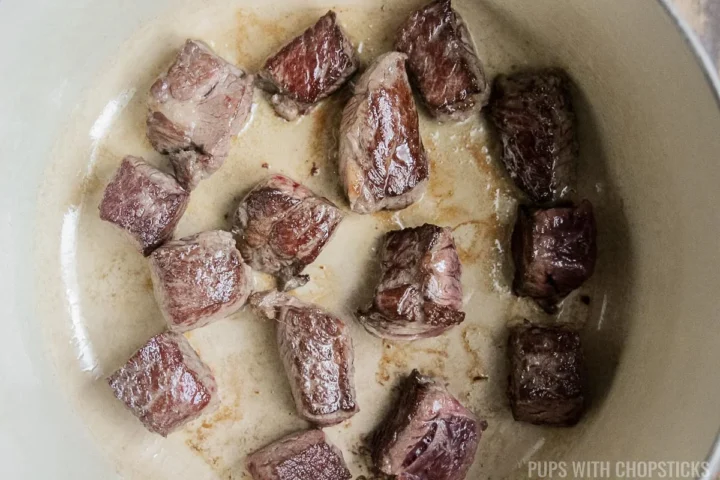
- Remove the beef from the pot and set it aside for later.
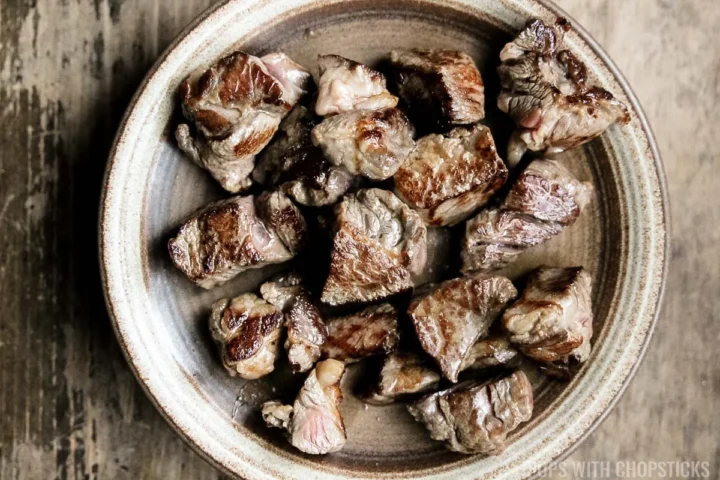
Prepare the Rest of the Braise
- Add the sliced ginger, sliced onions, 2 bay leaves, and 3 star anise and brown for 2-3 minutes. Do not add the garlic. It's important that we do not brown the garlic, as it will create a hard shell that will prevent it from fully melting into the stew.
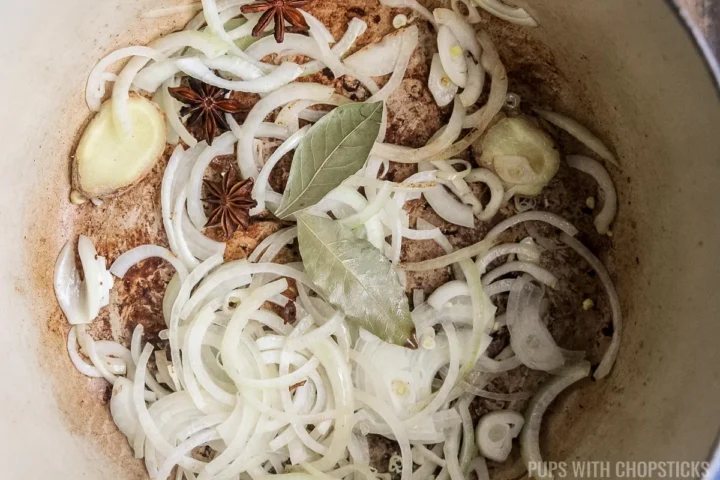
- Change stove to Medium-Low heat.
- Add half of the braising sauce to the pot, and use a wooden spoon to scrape the brown bits on the bottom of the pot. These burnt bits are full of flavor, and are called 'Fond'. Once you have scraped most of the brown bits, add the rest of the braising sauce to the pot.
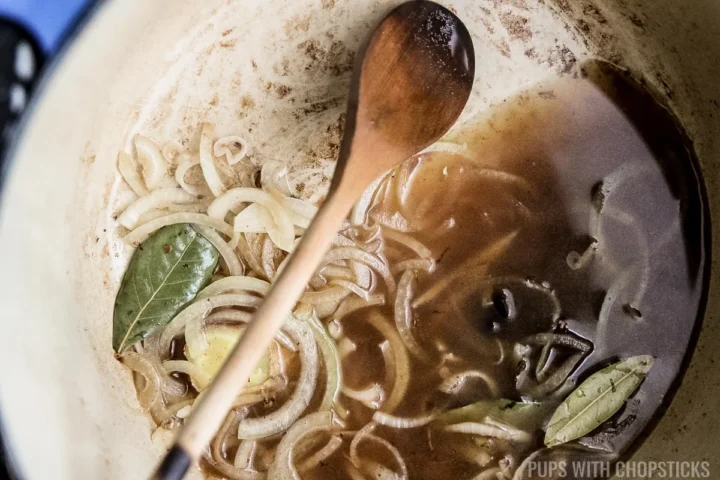
- Add the browned beef, and the smashed garlic cloves to the pot and mix everything together.
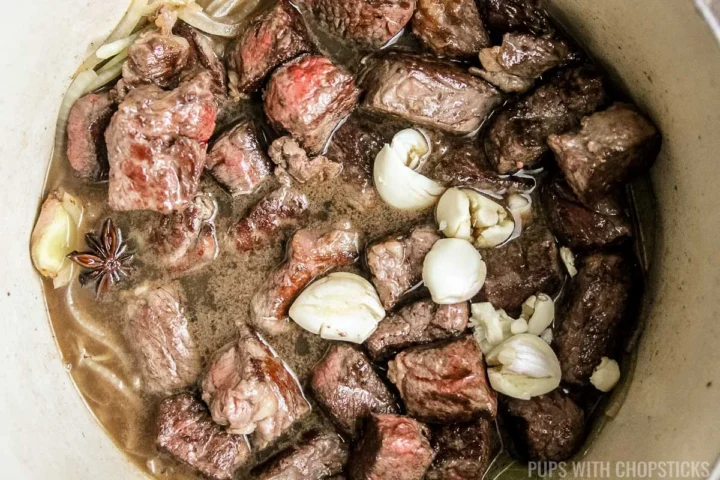
- Put the lid on, and braise everything for 60 minutes. At 30 minutes, check the water levels to make sure there is still enough liquid in the pot to braise the beef. If the water levels are too low, add about ½ cup of water. (The beef should be halfway submerged in liquid.)
- Add the daikon (and pressure cooked tendon if you are using) and cook for 30 minutes.
- After 30 minutes, poke a daikon with a skewer or knife. It should be soft, and the knife should easily go through it. If it is still hard, add a few more minutes of braising.
- Add the green onions in, and stir the stew and let the residual heat wilt it. Do a taste test, if it needs more salt, add it in now.
- Your Chinese beef stew is now ready! Serve it with rice or noodles and enjoy the rich, flavorful sauce and tender chunks of beef.
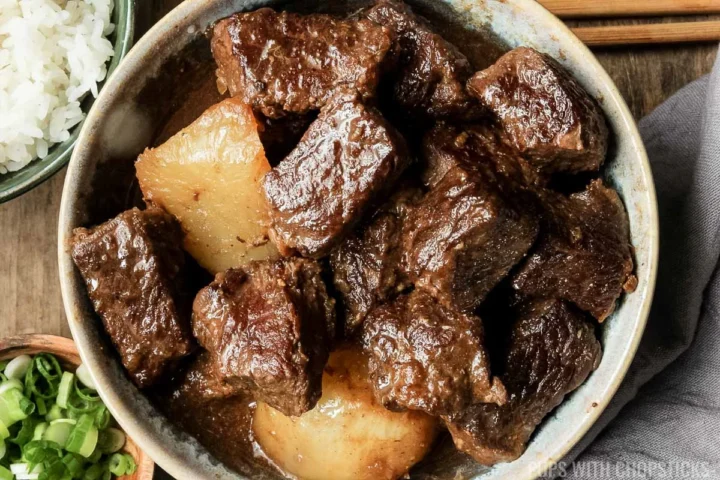
Notes
-
- Choose the Right Cut of Beef: For this Chinese beef stew recipe, I always use beef chuck, which are also called blade roasts. These cuts are perfect for stews as they become tender and flavorful when cooked low and slow. Look for beef with a good fat to meat marbling ratio, this will give you the most flavor and texture. Alternatively, you can also use beef brisket as well, but you may need to cook it longer (and add more water to the braise) to break down the tough and chewy connective tissues. It's very important you don't use generic 'stewing beef' from the grocery store, because those tend to produce dry and stringy beef stew.
-
- How To Pick Daikon Radish: When shopping for daikon, you want to pick the ones that are smooth and not blemished, but most importantly heavy for it's size and firm. This means the daikon is fresh because there's still a lot of water in it. Give it a squeeze, make sure it's not soft or turgid. It should feel firm like a potato.
-
- How to Remove Bitterness from Daikon: To ensure that your daikon doesn't have any bitterness (which can transfer to your beef stew), peel your daikon a few times until it has changed to a different color. The outer layers of the daikon, is where the bitter flavor usually comes from, and the more tender deeper layers are sweeter.
-
- Always Scrape Off the 'Fond' for Best Flavor: While you are browning your meat, you will notice that there will be brown bits on the bottom of our pan. This is flavor, and called 'Fond'. Adding 1 cup of liquid will loosen it up, which will make it easier for you to scrape up to give your stew additional flavor!
-
- Beef Tendon Needs Pressure Cooking: If you're using beef tendon (which is optional), make sure to pressure cook it for 40-45 minutes before adding it to the stew. This will ensure that the tendon becomes tender and doesn't require an excessively long braise time.
-
- Browning the Beef For Best Flavor: To get the best flavor, it's important to brown your beef before you braise it. The best way to do it is to blot out as much moisture out of the meat and then salt it before you add it to hot oil. Usually the salt draws out more moisture in meat but in this case, if you brown it right after salting, it actually helps with the Maillard reaction, and makes the beef not stick to the pan as much. Just make sure not to touch the beef right away once it's in the oil. You want it to form a crust which will take a few seconds, before you flip it.
-
- How To Use Extra Red Fermented Bean Curd: If you don't know what to do with the leftover jar of red fermented bean curd, you can also make authentic char siu with it! The red in the sauce is what will help give your char siu it's red color without food coloring.
Nutrition
Calories: 495kcal | Carbohydrates: 16g | Protein: 46g | Fat: 27g | Saturated Fat: 12g | Polyunsaturated Fat: 2g | Monounsaturated Fat: 13g | Trans Fat: 2g | Cholesterol: 157mg | Sodium: 1049mg | Potassium: 1076mg | Fiber: 3g | Sugar: 8g | Vitamin A: 96IU | Vitamin C: 22mg | Calcium: 93mg | Iron: 6mg
